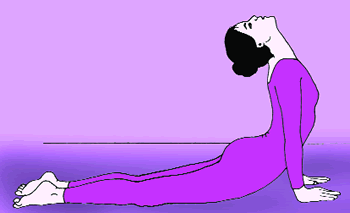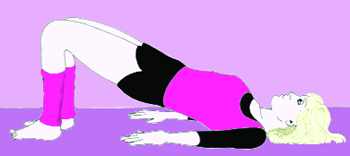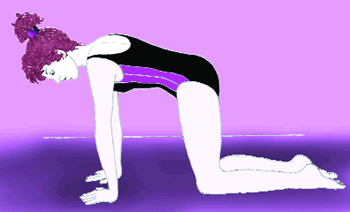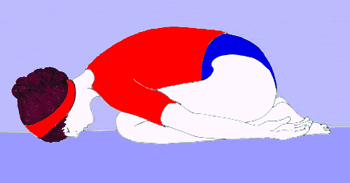Positive Health Online
Your Country

Yoga and Macrobiotics for Back Pain
listed in yoga, originally published in issue 95 - January 2004
Many of us have heard of and benefitted from the internal use of ginger and its wonderfully healing properties, but relatively few of us have heard of the benefits of how ginger can be used externally. According to Macrobiotics, many types of pain can be relieved through the use of a ginger compress. Both simple and effective, the ginger compress has been known to relieve back pain, menstrual cramps, arthritis, stiff neck and kidney stone attacks. Macrobiotic techniques have proved time and time again to be efficient and effective. Not only is it inexpensive, it is so easy to prepare and apply that you could do it with a friend in the comfort of your own home and, lastly, it has the added benefit of not producing undesirable side effects.
How can a Ginger Compress Help Me?
Often pain can be felt in areas of the body where the flow of energy is stagnant. A ginger compress helps to stimulate and increase the circulation of blood and body fluids and disperses stagnant energy. The strong heat applied during a ginger compress works on many levels to benefit the body – dilating the blood vessels, activating stagnant fluids and melting mucus stagnations, the ginger penetrates deep into the body. Simultaneously, as the ginger penetrates the body, fat accumulations disperse. No ladies, this does not mean that ginger compress should be used as a way to lose those extra pounds, but it could be a relatively small side effect. More importantly, ginger increases the circulation in the body so that gradually the tissue that is being treated becomes cleansed, nourished and revitalized.
Precautions
A ginger compress is safe for most people and in many situations. However, there are certain situations in which the ginger compress should not be used. These include:
• On old people or babies;
• On the brain area;
• On the lower abdominal area of a pregnant woman;
• On an inflamed appendix;
• When high fever is being experienced;
• For no more than five minutes on a cancerous tumour.
How Soon Will I Feel the Effects of a Ginger Compress?
I tried it myself at home one night when my lower back was hurting, and can say with confidence that the ginger compress produces results relatively quickly. Of course, it does depend on numerous factors, including the severity and depth of the pain. Although the compress may bring you symptomatic relief, it does not remove the basic cause of the problem. To go deeper into the cause of your pain, it is advisable to combine other forms of alternative therapy in a healing programme that meets your personal needs. For example, you may wish to investigate more about various therapies, such as shiatsu, reflexology and remedial massage, and perhaps to include with these some form of counselling or personal development work.
Ingredients for a Ginger Compress
All you need is:
• fresh ginger roots;
• a large, heavy pot, with a lid, that can hold at least one gallon of water;
• a gallon of water;
• a grater;
• a large, thick bath towel;
• three small kitchen cloths;
• a small cotton bag with a string so that it can be closed tightly.
What Do I Do?
It is very simple…
1. First, bring a gallon of water to the boil in a covered pot. Simultaneously, wash and grate 100 grams of ginger roots in a circular motion;
2. Wet the cotton bag and put the ginger in the bag;
3. Close the bag tightly;
4. As soon as the water in the pot begins to boil, turn down the heat so that the water is only simmering. From this point onwards, the water should not be brought to boiling point again, as it will destroy the active ingredients of the ginger;
5. Uncover the pot. Squeeze the bag over the pot and then drop it into the water;
6. Cover the pot again and let it simmer for five minutes;
7. Watch as the liquid becomes yellowish and then turn off the heat completely;
8. Remove the pot and prepare to give yourself a ginger compress.
How to Apply a Ginger Compress?
Whilst it is usually easy to give yourself a compress, the back is not as easy to reach as other parts of the body, and so it is advisable to get a friend to help you. The person who is working on you may wish to use gloves if they will feel more comfortable.
Remembering that the compress is given whilst the water is still fairly hot, don't waste too much time getting started, although you can always reheat the water slightly if it becomes too cool during the process of applying the compress. To begin, follow these ten easy steps:
1. Lie down comfortably on the floor;
2. Fold a kitchen towel in half and then again so that the length of it is long and the width is short;
3. Remove the lid from the pot and dip the middle part of the towel into the water, holding each end in either hand;
4. Squeeze a little of the water out of the towel back into the pot;
5. Unfold the steaming towel and refold it so that it will best fit the area that is going to be treated;
6. Test that the towel is not too hot to be applied directly to the skin by bringing it close to your face. If it is too hot then you won't be comfortable having it close to your face. Be careful not to burn the skin;
7. Apply the towel (or towels, if the area is very large) directly to the area that is being treated. The towel should be as hot as the person can handle. Fortunately, in this situation, the back is not as sensitive to heat as other areas of the body;
8. To keep the treated area as hot as possible, place one or two larger dry towels over the wet towels. This will ensure that the heat is retained for between three and ten minutes;
9. As soon as the person being treated no longer feels the heat of the compress, apply a new one;
10. Keep applying a new compress until the skin of the treated area remains a lasting deep red colour. This process could take between 20 and 30 minutes.
After the treatment, rinse and dry the towels. It is a good idea to keep them separate from your other towels and use them only for ginger compresses.
Note that the ginger water you prepared will lose its potency within two or three hours, so, if you are treating a serious condition, you will have to prepare fresh ginger water if you wish to apply a second treatment. For less serious conditions, you can reuse the ginger water within 24 hours.
Other Useful Tips
• Ginger water that is older than 24 hours can be reheated and added to your bath to invigorate your system.
• Ginger water also makes a fantastic solution for a footbath. This practice is said to promote good sleep.
• Scrubbing the body with ginger water first thing in the morning is very stimulating – a great way to start the day!
What Else for Back Pain?
Yoga for Backpain
Whilst yoga cannot guarantee particular benefits for certain ailments and is not merely a recipe for less suffering, certain yoga asanas (yoga positions) can bring relief to areas of the body in which we experience pain. The following asanas have been helpful in the reduction of back pain.
Cobra
Lie down on your stomach and relax completely. Place your hands under your shoulders so that your palms are resting flat against the ground. Take a deep breath and slowly raise the top half of your body off the ground, moving slowly so that you can feel each vertebra arching back. Allow your head to drop back so that you feel the stretch in your throat. Keep the arms bent and your elbows tucked in close to the sides of your body. Take a few normal breaths whilst holding this position and then, very slowly, lower your body to the ground. Breathe out and relax.
When you are more confident you can move to the next stage of the cobra, straightening your arms as you raise the top half of your body off the ground. Complete five rounds and relax completely. As you do the cobra, make sure you are not over-extending the lower back. No pain should be felt in the lower back.

The Cobra
Half wheel
Once again, lie down on your back. Make sure that your body is in a straight line. Slowly bend your legs and bring your heels as close to your buttocks as you can. Make sure that your feet are flat on the ground. If possible, take hold of your ankles with your hands; otherwise, rest your hands on the ground next to your body. Take a deep breath in and, whilst holding your breath, gently lift the middle portion of your body off the ground. Squeeze your buttocks. Release the breath and hold the position for a few seconds whilst breathing normally. Take a deep breath in, then, as you breathe out, gradually lower your body to the ground. Repeat two or three times. Relax completely on your back and breathe normally.

The Half Wheel
Child's pose
The child's pose is a great asana to rest in directly after practising the cat stretch. From the cat stretch, gently shift your buttocks back so that you are sitting on your heels. Relax your arms and hands beside you on the ground. Rest your forehead on the ground and relax the body as much as you can, breathing gently. If you can, hold for ten minutes, relaxing as much as you can. Otherwise, hold for as long as is comfortable for you. You may find that the blood seems to stop circulating through your legs when you first practise the child's pose, but with practice this will disappear.

The Cat Stretch

The Child's Pose
The Power of Meditation
Most of us are aware of how what we do to our body affects our mind. Our body is an outward representation of what is going on in our mind. When we take time to calm and clear our mind, our body automatically benefits. Every day we wash our bodies and take care of ourselves from a hygienic perspective, but what do we do for our minds? What do we do to keep the mind uncluttered and calm? Meditation is a way of cleaning the mind, washing it from within, so that we can be calmer, clearer and happier. Without meditation, the restlessness of the mind affects us on all levels, often manifesting as pain or illness in the body, and prevents us from connecting with the joy within us. Meditation frees us from tension and brings back our smiles. Teaching yourself meditation can be a bit daunting and frustrating, but there are many teachers around from whom you can receive guidance. All you need to do is to try a few techniques for yourself, and then, once you have found a technique that suits you, it's just about practice, until you reach the stage where you love it so much that it becomes part of your daily life naturally.
Does Your Chair Support You?
Perhaps the chairs you sit in cause you a lot of discomfort but you haven't been aware of it. If you spend a lot of time in a chair or in certain chairs, then it a good idea to make sure that they are not only comfortable, but, more importantly, supportive. Also, if you do spend hours each day in a chair, make sure you take a break from sitting – walk around, stretch your legs, make sure the circulation in your body is not becoming stagnant.
How Good is Your Posture?
Most of us could do with some improvement on our posture. Notice yourself when you are standing, chatting with your friends or waiting for the bus. Notice yourself when you are sitting at your desk. Many back pain problems begin with and are aggravated by poor posture. Stand tall and sit up straight at all times. If you work at a desk, make sure that your desk posture is right. Good desk posture includes not pushing your head forward or slouching on your desk. If you work in front of a computer, set up the computer screen so that it is in line with your eyes and position your keyboard so that you arms can be approximately parallel to the ground.
Your Sleeping Position
Your sleeping position has a huge effect on the alignment of your body and could be putting additional and unnecessary pressure on your back. Observe the position in which you sleep and notice if you have any recurring patterns which affect your back. If you sleep on your side, it is a good idea to place a thin pillow between your legs. This helps to keep the spine straight and could play a part in minimizing back ache. Lastly, make sure the mattress you sleep on is firm and strong.
Do You Create Unnecessary Strain?
Become aware of the times when perhaps you are putting extra strain on your back. Carrying heavy objects or oddly shaped bags with most of the weight on one side of the body can impact on the spine and cause pain. Small changes may be all that you need – a bag that you can carry on your back that is comfortable and strong, for example, can make all the difference.
Relaxation
Pain in your body is a sign that something is not quite right. It is your body's way of demanding your attention as a last resort. Pain can also be an indication of simply needing more rest. Take time to relax, to be alone, to spend quality time with yourself doing nothing in particular. The more relaxed you are, the more inappropriate your body is for hosting pain.
I hope that those of you with back pain who have read this article may be inspired and empowered to do something positive about it. Happy, healthy lives are our birth right! There is no reason why we should not live happy lives with maximum health at all times. Enjoy the journey!
Comments:
-
asamoah felix said..
I am experiencing a back pain for the past six months. mine is part of my back and cuts across to my stomach and ends up at my cod which i had a hernia operation about five to six years ago.it is the flesh itself which makes me feel like i have been lashed.i have to make a scann but they did not see anything. but for the pain i,m still feeling it, kindly help and advice me.